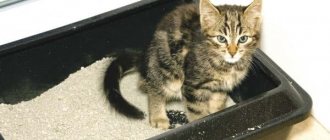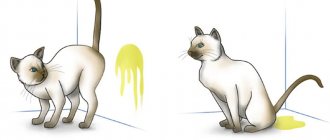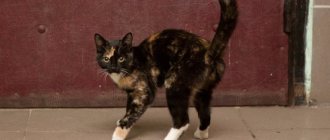There are several explanations for why your cat might suddenly abandon the litter box and start pooping in the shower, bathtub, or sink. This is an unfortunate turn of events. Luckily, if your kitten is healthy, you can probably stop this unwanted behavior by changing things up in the bathroom and making the litter box more attractive.
Bathroom behavior varies from cat to cat, and litter box problems may be related to an underlying health condition, stress, environmental factors, or a combination of any of these. You will benefit from spending some time learning about your cat's emotional and physical health so you can determine what the problem is and how best to address it.
Health
Firstly, the state of health. Sometimes cats shit right in front of their owners, and in the most unexpected places. As a rule, the owners begin to think God knows what - they say they are taking revenge on us for something. In fact, everything is not like that! This behavior is nothing more than a kind of cry for help. For example, cystitis in cats is accompanied by involuntary urination. Very often something similar happens in the sink or bathtub. Another question: a cat in pain may feel uncomfortable using the litter box. Finally, he begins to be associated in her mind with pain. And she begins to select other, more “suitable” places for emptying.
Your capabilities and cat's needs
Animals, like people, have their own character and their own needs. Very clean animals may not tolerate poop in their litter box and will defiantly go to the bathroom. Why is this suddenly happening? There can be many reasons:
- you went to work and can no longer run all day to the pussy tray to clean it;
- you adopted a cat for foster care and did not expect such behavior, because your animal is less whimsical;
- for some reason you are forced to change the manufacturer of the filler. And the new litter, according to the cat, does a poor job of absorbing odor or moisture;
- you got another animal, which decided that the litter box of the first cat suited it very well and “spoiled” it with its smell.
Essentially, the cat is telling you: when I go to the bathroom, you immediately clean up the pile, but it stays in my tray for a long time. I do not like it!
What to do with all this? Go choose a new filler. Try what your cat might like. For example, purchase a larger tray in which the animal can bury its feces while you are away from home. Just look, it takes a month for the cat to get used to the new offer. Also make sure that other animals do not pee in the cat's litter box.
But, there is another approach. Some animal psychologists recommend offering such perfectionist animals to use the toilet. Just make or buy a cat stand so that he doesn't fall into the toilet, and drop him off for big errands for a while. Interestingly, there is a certain percentage of cats who really like it. And who willingly begin to relieve themselves just like people. Moreover, according to behavioral experts, “sitting” on a hill is regarded by animals as a safer place. Like, I sit high, I look far away, I control everything.
Stress
Thirdly, the general stress situation in the animal. The cat has changed its place of residence twice in the last period of time: its previous owners abandoned it and gave it to a shelter, then again to a new home. Cats generally hate sudden changes in their lives!
Something needs to be done! So, we have looked at the most likely reasons. But this is not all, because for each cat everything is strictly individual. So, a cat can simply mark the sink and bathtub with his feces - that’s how he likes them. He likes that these items now hold his scents.
An important factor: the cat has had its claws removed. These cats find it very unpleasant to dig around in the litter box and prefer cool, smooth surfaces. The bathtub and sink fit perfectly!
Stress and changes in a cat's life
Has your baby (in the sense of a human child) learned to walk, have you got another pet or moved into a house with new household members? Keep track, perhaps someone is frightening or offending the cat while he is about to relieve himself, and he is simply interested in a safe place. After all, the high sides of the bathroom help him “hide.” In this case, it is worth purchasing a new tray with high walls. Some experts in animal behavior and experts in saving the family budget give good advice: they remake children's bathtubs to accommodate such devices. Or their animals prefer a large plastic box. They cut convenient holes in them and placed them in safe places. But, you will still have to accustom the cat to the new latrine. Keep track of when he wants to go to the toilet and transfer him to a new improvised or industrial tray. Sometimes the cat likes everything and gets used to it quickly, sometimes it takes several weeks. It all depends on the ability to pay a lot of attention to training.
By the way, at the same time you will have to close unwanted waste: draw the curtain in the bathroom, cover the sinks with cutting boards or basins. This way the cat will not have the opportunity to choose.
Imitation
Finally, another reason is what I call “imitative behavior.” Was the cat allowed to see how people wash themselves in the bathroom, the water that cats hate so much is flowing in streams? But now, when it’s quiet there, a cunning cat sneaks in and tries to “win” it all. The cat often sees his owners in the bathroom and believes that he has a place there, too.
However, let's summarize. What would I advise you to do? First, get another tray. Look, suddenly his fate will turn out much more “successfully”. Secondly, why not place this tray right in the bath? Or, at worst, put an empty box or drawer there? If the cat is so fond of going to the toilet in the bath, then why not meet him halfway? After all, cleaning the tray, whatever one may say, is much easier than the bath itself. The main thing is to remember to take it out before you start washing! Good luck!
Original publication: Why Is My Cat Pooping in the Sink and Bathtub? Author: Amy Shojai Source and photo:
Ways to discourage a pet
You can discourage the animal from this place using bleach.
Cat owners who are faced with the problem of their pet urinating in the bathtub or sink have developed the following effective techniques for changing the habit:
- Set of water. If you leave a small layer of liquid at the bottom of the bath, your pet will gradually stop jumping inside.
- Food. Cats never relieve themselves where they eat, so you can leave your favorite cat treats in the bath 2-3 times.
- Natural flavors. Essential oils - lemon, orange or grapefruit - help to repel cats. Zest or fresh peels of citrus fruits are no less effective, but they do not look very attractive. It is recommended to add additional drops of extracts under the bath.
- Perfume. If there is a strong smell to which the cat reacts negatively, then you can spray the plumbing.
- Cleaning with bleach. If the surface marked by the pet is not washed and the smell of urine is not removed, it will not be possible to wean the pet.
- Spiky rug. The cat does not go to relieve itself on uncomfortable surfaces, so you can put artificial turf or uncomfortable plastic bedding in the bathroom.
- Insulation. If the tray is not located in the bathroom, then the door can simply be closed. Gradually the cat will change old habits.
The older the animal, the more difficult it is to change its habits, so it is important to immediately show the kitten where to relieve itself.
In pet stores you can buy a special spray with a cat-repellent smell. Veterinarians recommend Mr. Fresh, Best Friend, Fernhaltespray TX-2928 Trixie and Antigadin. To quickly wean your pet from the wrong place, you can also treat the tray with special odors that encourage urination. Similar sprays can also be purchased at a pet store. Felinologists recommend praising and rewarding your cat every time he relieves himself in his toilet in order to reinforce the desired behavior.
How to stop a cat from pooping in the wrong place
If a cat stops going to the litter box, it needs to be weaned off littering anywhere as soon as possible. Otherwise, soon the whole house will be saturated with the pungent smell of animal excrement. And in order to quickly achieve the desired result, methods of influencing your pet must be chosen taking into account the reasons for its behavior.
Change tray or filler
If your cat starts pooping everywhere, it may be that she has complaints about the configuration or dimensions of the litter box. In this case, the pot will have to be replaced with another model. Many owners forget that kittens grow quickly and no longer fit into the old tray. In this case, the cat begins to pee in the wrong place, and the problem can only be solved by selecting a pot of the appropriate size.
Also, when buying a toilet for your pet, you need to pay attention to the height of the sides of the model you like.
Boxes with too high walls are not suitable for kittens and older cats, and large adult cats need deeper trays. Important! When purchasing a tray, you should pay attention to the quality of the materials from which it is made. So that the cat does not shit in the wrong place and regularly goes to the potty, it must be made from expensive raw materials. Products made from low-quality plastic have a pungent odor that repels animals.
To stop a cat from shitting in the wrong place, she needs to choose a suitable litter. If, instead of the usual clumping option, wood or mineral granules were poured into the tray, the animal may refuse to use the tray. In this case, you can stop him from crapping in the corners by simply returning the original filler.
On a note. If a kitten appears in the house, whose preferences are not yet known, you need to try different filler options, including regular sand and torn paper. Sometimes it happens that your pet prefers to use an empty potty with a net.
Eliminate stress
If a cat begins to shit in the wrong place due to stress, you need to be patient and not punish it. It is important that the pet feels safe with its owner.
To improve your emotional state, you can allow your cat to sleep closer to you. It may happen that after adaptation, the pet begins to go to the litter box on its own. But the owner can speed up this process by treating the corner in which the shit is pooped with repellents.
How to treat a place where a cat shits so that it doesn't shit anymore
You can stop your cat from shitting anywhere using folk remedies and commercial repellent sprays.
Folk remedies
Simple but time-tested methods will help you discourage your cat from pooping in the wrong place:
- If a cat poops in a flower pot, you can use toothpicks to stop him from doing it again. They are densely stuck into the ground so that the pet has nowhere to step. This method will help to permanently stop your cat from shitting in the wrong place, but it is quite traumatic. It is much more humane to protect flowerpots using double-sided tape or homemade covers cut from cardboard or other materials.
- If your cat poops on the carpet or bed, you can use water to make her stop defecating in the wrong place. Noticing that the pet is about to go to the toilet, it is sprayed with a spray bottle. Usually, 2-3 such lessons are enough to stop a cat from shitting in the wrong place.
- Every time you try to pee, you can clap your hands loudly anywhere. A sharp sound will scare away the animal and help quickly accustom it to order.
- It’s easy to stop a kitten from crapping in the wrong place by placing foil in the corners it likes. The baby is unlikely to like the rustling material and will stop defecating anywhere.
- You can stop your cat from shitting in the corner by placing garlic, citrus peels, burnt paper, hot pepper or mustard in this place.
- You can remove cat smell from interior items and wardrobe by washing them with hydrogen peroxide, alcohol or iodine. Expert advice. A bite and bleach are not suitable for stopping a cat from shitting anywhere. These substances are not only dangerous to the health of pets, but also increase the smell of their urine. If the corner in which the cat gets into the habit of pooping is washed with a solution of bleach or vinegar, then it will attract it even more.
Tray changes
Making some simple changes to the litter box itself can help in this situation. Install a second litter box, preferably in another room, so your cat has the option. Empty litter boxes up to 2 or 3 times a day and clean them once a week. Try using a larger litter box to encourage use. Choose the size of the litter box based on the size of your cat, not the space it will fit. The box should be approximately 1.5 times the size of your cat.
What cat habits are annoying?
Some of the habits of mustachioed robbers and robbers lead the whole family to despair. What should you do if the animal constantly jumps on all surfaces, breaks dishes, bites painfully, scratches, hisses, growls, meows loudly?
Jackson Galaxy, the author of the program “My Hell Cat,” advises keeping the animal occupied with games, which will expend energy, calm down, and stop destroying everything around it.
But if the owners understand or re-educate a cat with a complex character without any problems, unpleasant toilet habits are difficult to correct. The owners of nurseries, shelters, and ordinary owners of a red Murka or a silver Barsik know this.
When a four-legged pet's tray is clean, filled with fresh substrate, the animal itself is neutered, is not under stress, but continues to leave marks anywhere, this is doubly terrible. A small apartment - carpets, floors, shoes, plumbing - is permeated with a stench.
If a cat uses a bathtub as a toilet, the owners have to constantly clean it. And this does not always help eliminate disgusting odors. The whole family is looking on the Internet for information on how to renovate a bathroom - videos or articles.
But there is another excellent way out of this situation: get serious about raising a pet.
Behavioral problems
Changes in household dynamics are a common cause of stress and anxiety in sensitive cats and can lead to them defecating outside the litter box.
Examples of this include an addition to the family, such as the birth of a new child, or the loss of a family member. Additionally, major changes to your daily routine can cause stress for your cat, such as a new work schedule or increased time the cat is left alone.
Of course, adding a new pet to the home can also lead to unplanned house contamination.
Defecating outside the litter box is rarely a form of room marking, as it most often involves urinating on vertical surfaces.
Next steps
If your cat continues this behavior even after environmental changes have been made, a feline veterinarian may be helpful.
This person can help teach your cat appropriate behavior and can come up with some solutions that are specific to your cat and living situation.
Some behavioral problems, especially those related to anxiety, can be treated with behavior-modifying medications. If the problem persists, discuss this option with your veterinarian.
Never give your pet medications intended for use in humans.
Why do cats defecate in the bathtub or sink?
Cats are generally very clean and tidy animals. When your cat defecates in a restricted area after conscientiously using the litter box, she is trying to tell you something.
First, check the tray to make sure it's not full, smelly, or tipped over. Also, make sure nothing is blocking your cat's access to the litter box.
Anything that seems inappropriate for your cat in the litter box may encourage her to take her business elsewhere.











